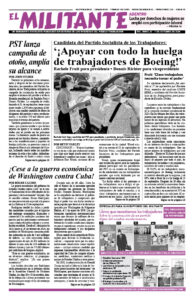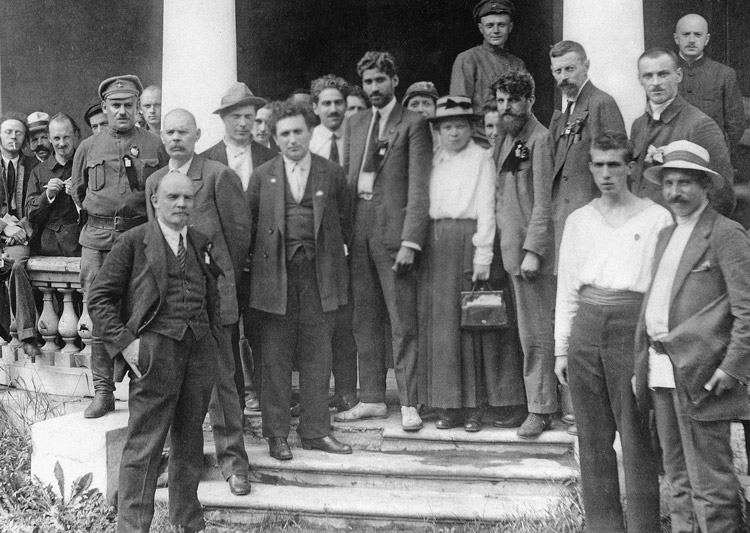The Changing Face of U.S. Politics: Working-Class Politics and the Trade Unions is one of Pathfinder’s Books of the Month for September. Parts of this book and important new material has been published in a new book, The Turn to Industry: Forging a Proletarian Party. The author of both is Jack Barnes, national secretary of the Socialist Workers Party. The excerpt is from “A new stage of revolutionary working-class politics,” part of the political resolution adopted by the 30th national convention of the SWP in August 1979. Copyright © 2002 by Pathfinder Press. Reprinted by permission.
Before World War I, the Marxist movement talked only of principles and tactics; it didn’t really have a strategy.
Principles are what we’ve sometimes called “red light” questions — if you start crossing them, a big red stoplight should flash on in your head. You don’t support imperialist wars. You don’t breach class independence.
These are principles. They are more often things “thou shalt not do” than things “thou shalt do.”
Principles are very important. They are not just dreamed up. A high price is paid for them in blood. They are lessons drawn from the experiences of the working class and its struggles. If you begin breaching them, you cannot build a revolutionary working-class party.
In 1928, a full decade before he drafted the Transitional Program, [Leon] Trotsky wrote about the pre-World War I socialist movement’s lack of a strategic conception.
“Prior to the war,” he wrote, “we spoke only of the tactics of the proletarian party; this conception conformed adequately enough to the then prevailing trade union, parliamentary methods which did not transcend the limits of the day-to-day demands and tasks.
“By the conception of tactics,” Trotsky explained, “is understood the system of measures that serves a single current task or a single branch of the class struggle.”
But that’s not enough, Trotsky said. “Revolutionary strategy on the contrary embraces a combined system of actions which by their association, consistency, and growth must lead the proletariat to the conquest of power.”
“Tactics are subordinate to strategy,” Trotsky said. And strategy serves as the indispensable link between tactics, on the one hand, and principles and the socialist goal, on the other.
World War I showed that the majority of leaders of the Second International did have a strategy — only it was not an acknowledged one and it led to disaster. Their strategy was to rely on their own bourgeoisie, to rely on a gradual accumulation of reforms under capitalism.
At the end of the war, however, the Bolsheviks showed in practice the kind of strategy needed to lead the working class to power.
By the mid-1920s, the revolutionary wave in Europe had subsided without further victories for the workers. The world capitalist expansion of that decade got under way. …
Periods such as these always create the illusion that reform is realistic. Capitalism doesn’t seem to be a crisis-ridden system. A lot of workers seem to be doing pretty well. Fewer and fewer workers sense a social crisis; those who do, or who understand that crises are built into the capitalist system, are a small minority. …
The fundamental class-against-class basis of politics becomes disguised in such periods. That is, the struggles that do break out often seem unrelated to class divisions in society. …
Those issues that are recognized as class-against-class by the general population, including big layers of the working class, come to be viewed very narrowly — what are often called “bread and butter” issues. These are seen as very limited struggles that don’t challenge the overall status quo. Political and social issues, on the other hand — including political solutions to economic needs — are not recognized as class questions at all.
The crisis in 1929 shook things up. It was the beginning of the end for illusions about capitalism’s reformability, its rosy future, its crisis-free existence. …
During the Great Depression of the 1930s, “bread and butter” issues became life-or-death questions that took on a direct social and political form. But it also became increasingly clear that social struggles were part of the class struggle, all part of the struggle between the exploiters and the exploited.
Under these conditions, and after extensive discussions with American comrades and comrades from Europe who could make it to Mexico, Trotsky drafted the Transitional Program in 1938. This exemplifies the strategy and method that we must understand more thoroughly than ever today so that we can apply it under new and different conditions to build the revolutionary party.
If it’s not understood that the Transitional Program is a strategic document aimed at furthering the construction of proletarian combat parties, then the whole point is missed. …
Trotsky continued: “The present epoch is distinguished not because it frees the revolutionary party from day-to-day work but because it permits this work to be carried on indissolubly with the actual tasks of the revolution. … It carries on this day-to-day work within the framework of the correct actual, that is, revolutionary, perspective.” The party becomes capable of imparting this perspective to more and more workers.
“Insofar as the old partial, ‘minimal’ demands of the masses clash with the destructive and degrading tendencies of decadent capitalism,” says Trotsky, “and this occurs at each step — the Fourth International advances a system of transitional demands.”
The essence of these transitional demands, Trotsky explains, “is contained in the fact that ever more openly and decisively they will be directed against the very foundations of the bourgeois regime.
“The old ‘minimal program’ is superseded by the transitional program,” Trotsky concludes, “the task of which lies in systematic mobilization of the masses for the proletarian revolution.”


